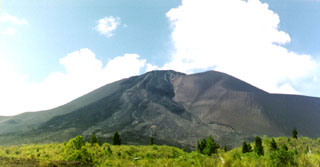Report on Soputan (Indonesia) — 3 February-9 February 2016
Smithsonian Institution / US Geological Survey
Weekly Volcanic Activity Report, 3 February-9 February 2016
Managing Editor: Sally Sennert.
Please cite this report as:
Global Volcanism Program, 2016. Report on Soputan (Indonesia) (Sennert, S, ed.). Weekly Volcanic Activity Report, 3 February-9 February 2016. Smithsonian Institution and US Geological Survey.
Soputan
Indonesia
1.112°N, 124.737°E; summit elev. 1785 m
All times are local (unless otherwise noted)
BNPB reported that explosions at Soputan were detected at 1300, 1437, and 2008 on 6 February; observers 10 km away saw dense reddish gray ash plumes rising 3 km above the crater. At 0106, 0204, 0311, and 0320 on 7 February Strombolian activity ejected tephra as high as 1 km above the crater. A pyroclastic flow traveled 2 km down the E flank. Thunderous sounds were reported, and dense ash plumes rose 2.5 km and drifted W. Constant tremor was detected. Ashfall was reported in multiple districts including Pasan (5 km SSE), Tombatu (16 km SSW), Belang (17 km SSE), and Ratatotok (20 km S). The Alert Level remained at 4 (on a scale of 1-4); residents and tourists were advised not to approach the craters within a radius of 4 km, or 6.5 km on the WSW flank. [Correction; the Alert Level remained at 3.]
Geological Summary. The Soputan stratovolcano on the southern rim of the Quaternary Tondano caldera on the northern arm of Sulawesi Island is one of Sulawesi's most active volcanoes. The youthful, largely unvegetated volcano is the only active cone in the Sempu-Soputan volcanic complex, which includes the Soputan caldera, Rindengan, and Manimporok (3.5 km ESE). Kawah Masem maar was formed in the W part of the caldera and contains a crater lake; sulfur has been extracted from fumarolic areas in the maar since 1938. Recent eruptions have originated at both the summit crater and Aeseput, a prominent NE-flank vent that formed in 1906 and was the source of intermittent major lava flows until 1924.

